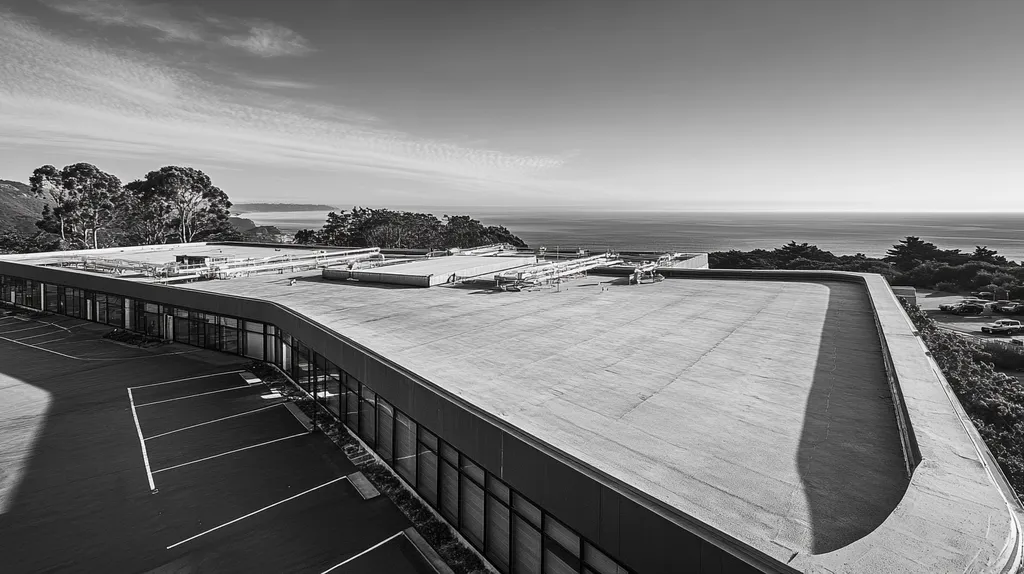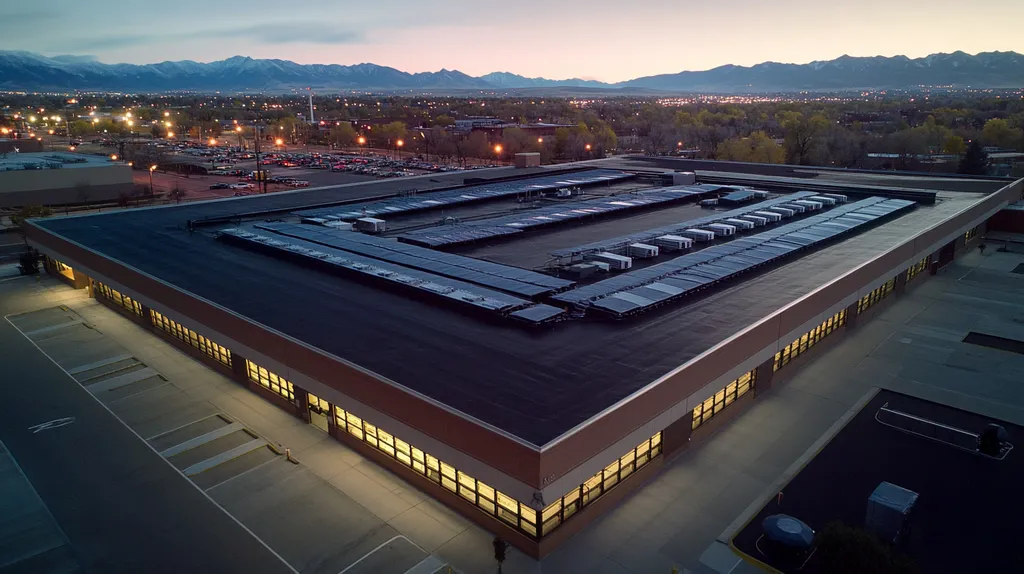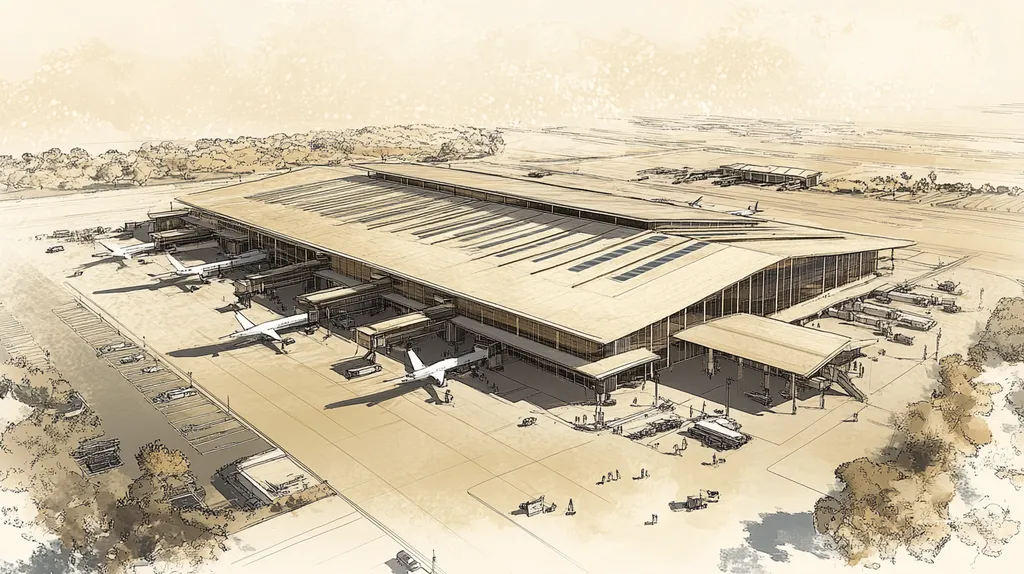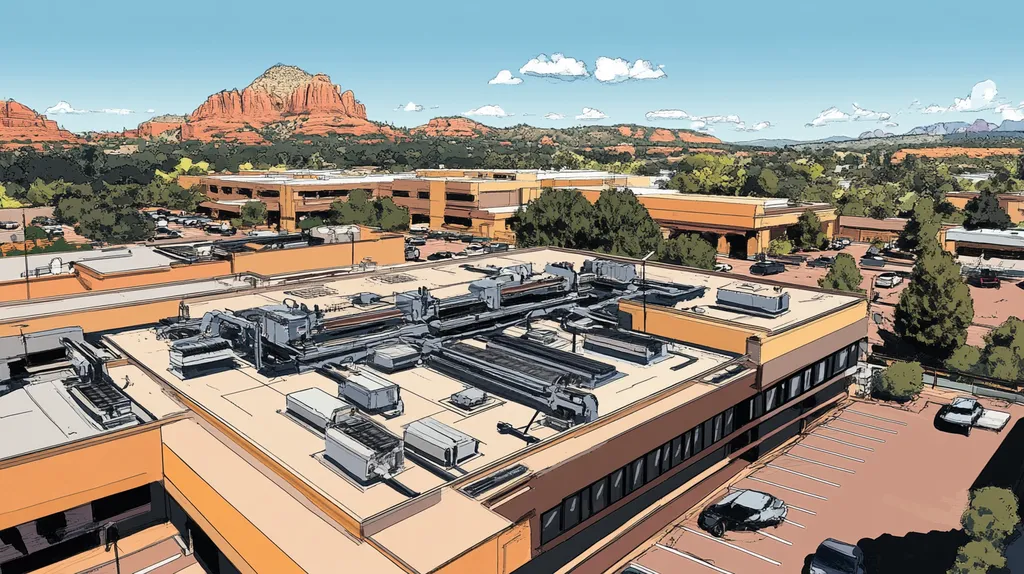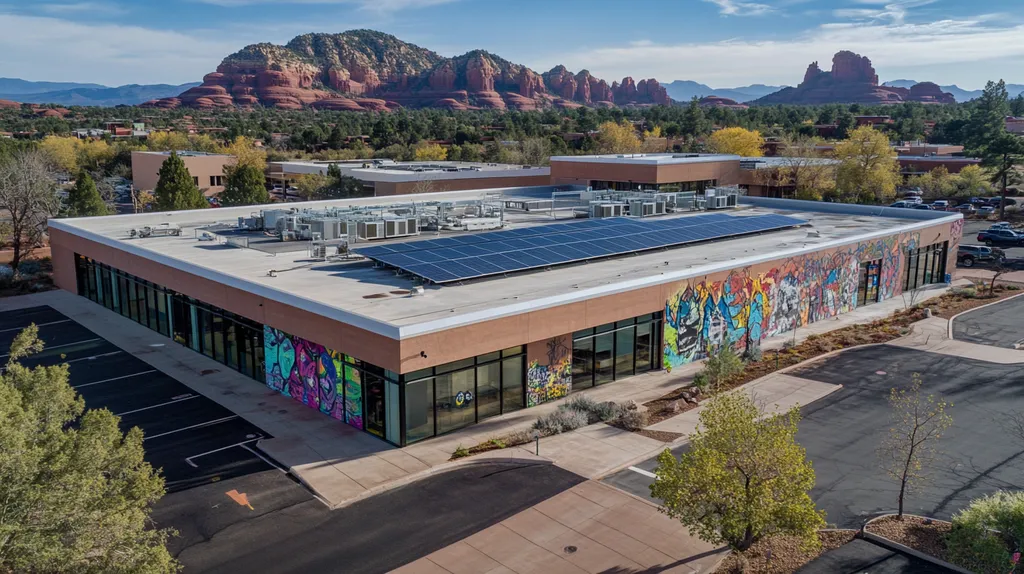In an era of increasingly extreme weather patterns, selecting the wrong commercial roofing material can result in catastrophic failures costing businesses millions in repairs and lost revenue. Industry data reveals that 40% of all commercial roof failures stem from improper material selection for rainfall conditions.
While manufacturers tout various solutions for heavy precipitation, the reality is far more complex than marketing materials suggest. From membrane composition to installation methods, every detail matters when protecting commercial investments from water damage.
This analysis cuts through common industry myths to reveal evidence-based solutions for high-rainfall environments, examining material performance data and long-term cost implications that every building owner needs to understand.
SECTION 1: COMMON MISCONCEPTIONS
When it comes to commercial roofing in areas with heavy rainfall, misconceptions can cost building owners millions in repairs and replacements. Studies show that water damage from improper roofing choices accounts for over 40% of building envelope failures. Understanding the truth about material performance, durability, and environmental factors is crucial for making informed decisions that protect your investment.
Rainfall and Roofing Material Selection
A dangerous assumption is that any commercial roofing material can effectively manage heavy rainfall. This oversimplification ignores critical factors like slope requirements, drainage capacity, and material-specific water resistance properties.
Proper drainage is essential for preventing water damage and maximizing roof longevity. A comprehensive water management system, including appropriate underlayments and overflow scuppers, provides crucial protection against leaks and structural damage. (source: Aquila Commercial)
Different roofing materials handle water flow differently. While TPO and PVC membranes excel in wet conditions due to their hot-air welded seams, materials like modified bitumen require specific installation techniques to prevent water infiltration.
The interaction between rainfall intensity and roof design also matters. A properly designed system considers local precipitation patterns and incorporates adequate drainage paths to prevent ponding water.
Misconceptions on Material Durability
Many property owners mistakenly believe that all commercial roofing materials offer similar durability. This misconception often leads to premature system failure and unexpected replacement costs.
Material longevity varies significantly based on environmental exposure. While some single-ply membranes may last 20-30 years in moderate climates, the same materials might require replacement much sooner in areas with intense UV exposure or frequent storms.
Installation quality dramatically impacts durability. Even the most robust materials can fail prematurely if improperly installed or if seams and flashings aren’t properly secured.
Regular inspections and maintenance significantly extend roof life. Many owners overlook this crucial factor when comparing material options, focusing solely on initial durability ratings.
Myths About Metal Roof Noise
The perception that metal roofs create excessive noise during rainfall remains one of the most persistent myths in commercial roofing. Modern metal roofing systems incorporate multiple layers that effectively dampen sound transmission.
Proper installation includes insulation and deck materials that reduce noise transfer. The combination of these components can actually make metal roofs quieter than traditional built-up roofing systems.
The type of metal panel and its attachment method influence acoustics. Standing seam systems with clip attachments typically produce less noise than through-fastened panels.
Sound ratings for properly installed metal roofs often match or exceed those of conventional roofing materials. This performance, combined with superior durability and energy efficiency, makes metal roofing an excellent choice for many commercial applications.
SECTION 2: PRACTICAL IMPLICATIONS
The stakes for commercial roofing have never been higher, with extreme weather events increasing in both frequency and intensity. Recent data shows that inadequate roofing materials in heavy rainfall areas can reduce a roof’s functional lifespan by up to 70%. For facility managers and building owners, understanding the practical implications of material selection is crucial for protecting their investment and ensuring business continuity.
Weather Resistance in Roofing
Weather resistance capabilities vary dramatically between roofing materials, particularly in their response to sustained heavy rainfall. Modern single-ply membranes like TPO and PVC offer superior water resistance through heat-welded seams and advanced polymer formulations.
The interaction between rainfall intensity and material performance creates specific challenges for commercial buildings. Materials must not only resist water penetration but also maintain their structural integrity under repeated exposure to moisture.
Advanced drainage systems play a crucial role in material longevity. Even the most water-resistant materials can fail prematurely if water accumulation isn’t properly managed through strategic placement of drains, scuppers, and adequate slope design.
UV exposure combined with rainfall can accelerate material degradation. Premium roofing materials often incorporate UV-resistant compounds that maintain water resistance properties even after years of sun exposure.
Impact on Roof Lifespan and Maintenance
Material selection directly influences maintenance frequency and overall lifecycle costs. High-performance materials may cost more initially but often require less frequent maintenance and offer extended service life.
Regular inspection schedules must align with material characteristics. While some materials need quarterly inspections in heavy rainfall areas, others may perform reliably with annual checks when properly installed.
Preventive maintenance costs vary significantly based on material choice. Materials designed specifically for high-rainfall environments typically require less intervention and have lower ongoing maintenance expenses.
The relationship between material quality and maintenance needs is particularly evident in seam and flashing durability. Superior materials maintain their integrity at these critical points, reducing the frequency of repairs and extending overall roof life.
Structural Integrity Concerns
Heavy rainfall creates substantial load demands on commercial roofs. Materials must maintain their structural properties while supporting potentially thousands of pounds of water weight during intense storms.
Thermal cycling from rainfall can stress roofing materials differently. Premium materials typically offer better dimensional stability, reducing the risk of separation at seams and maintaining watertight integrity.
The interface between roofing materials and structural components requires careful consideration. Different materials transfer loads differently to the building structure, affecting long-term performance and safety.
Material selection impacts the entire building envelope’s performance. Poor choices can lead to moisture infiltration that compromises not just the roof but also walls, insulation, and interior finishes.
SECTION 3: COST OF MISINFORMATION
The financial consequences of roofing material misinformation are staggering, with incorrect choices leading to premature failures that can cost organizations millions in repairs and business disruption. Recent industry data shows that choosing unsuitable materials for heavy rainfall environments can triple maintenance costs within the first five years. Understanding the true cost implications of roofing decisions has become critical as weather patterns intensify and building operational demands increase.
Financial Impact of Misguided Choices
Selecting inappropriate roofing materials based on misconceptions creates a cascade of costly consequences. Initial savings from choosing less suitable materials typically evaporate within 2-3 years as repair frequencies increase and water damage spreads.
Emergency repairs during heavy rainfall events can cost up to five times more than scheduled maintenance. These unexpected expenses often force organizations to divert funds from other critical building improvements or operations.
Water infiltration from failing roofs can damage expensive equipment, inventory, and interior finishes. The combined cost of direct repairs and secondary damage often exceeds what a proper initial installation would have cost.
Extreme conditions like heat, rain, snow, and wind cause significant damage which can increase maintenance and replacement costs if incorrect materials are used. (source: Five Points Roofing)
Cost-Effective Alternatives Over Time
Premium roofing materials engineered for heavy rainfall typically deliver superior return on investment through extended service life. While initial costs may be 20-30% higher, these materials often last twice as long as standard options.
Modern single-ply membranes and modified bitumen systems offer enhanced durability with minimal maintenance requirements. Their advanced formulations resist degradation from constant moisture exposure, reducing long-term repair needs.
High-performance roofing materials often include warranties spanning 20-30 years, providing valuable protection against premature failure. This warranty coverage can save organizations substantial replacement costs over the building’s lifetime.
Integrated drainage solutions and proper material selection work together to prevent costly ponding water issues. This systematic approach helps avoid the expense of correcting drainage problems after installation.
Long-Term Budget Considerations
Effective budgeting requires understanding the total cost of ownership beyond initial installation. Organizations must account for inspection frequencies, maintenance intervals, and potential repair scenarios based on material choice.
Lifecycle cost analysis reveals that premium materials often reduce total expenditure by 25-40% over a 20-year period. This savings comes from decreased maintenance needs and extended replacement intervals.
Business interruption costs from roof failures can dwarf the expense of proper materials. A single major leak can cost organizations tens of thousands in lost productivity and damaged equipment.
Energy efficiency gains from proper material selection contribute to long-term savings. Modern roofing systems can reduce cooling costs by 15-25% through better insulation and reflective properties.
SECTION 4: REALITY CHECK
In the high-stakes world of commercial roofing, separating marketing hype from proven performance can mean the difference between decades of protection and catastrophic failure. Industry data shows that 65% of premature roof failures stem from selecting materials unsuited for local rainfall conditions. Building owners must navigate a complex landscape of manufacturer claims, performance metrics, and real-world evidence to make informed decisions that protect their investments.
Evaluating Weather Resistance Claims
The roofing industry’s tendency to use vague terminology like “weather-resistant” or “all-climate” creates dangerous ambiguity for decision-makers. These terms lack standardized definitions and often mask significant performance variations under sustained heavy rainfall.
Third-party testing protocols provide crucial verification of manufacturer claims. Look for materials that have undergone ASTM D6754 testing for weathering resistance and ASTM E108 for fire resistance under wet conditions.
Wind-driven rain resistance proves particularly critical yet often goes unaddressed in marketing materials. Materials should demonstrate performance under combined wind and rain conditions, not just simple water exposure.
Installation methods significantly impact weather resistance capabilities. Even top-performing materials can fail if manufacturer-specified installation procedures aren’t followed precisely.
Comparing Material Performance Data
Performance metrics must be evaluated within the context of local climate patterns and building-specific requirements. Raw data without proper context can lead to misguided material selections that fail to address actual site conditions.
Seam strength testing provides critical insights into potential failure points. Heat-welded seams typically outperform adhesive-based systems in sustained rainfall, showing 30-40% greater resistance to water infiltration.
Material thickness variations can significantly impact performance. While thicker isn’t always better, inadequate thickness for local conditions can lead to premature aging and failure.
Surface degradation rates under repeated wet/dry cycles offer key predictive data. Materials showing minimal change after accelerated cycling tests typically deliver better long-term performance.
Real-World Case Studies
A major retail distribution center in the Pacific Northwest replaced their failing conventional built-up roof with a reinforced thermoplastic membrane. After five years of heavy rainfall exposure, the new system shows minimal degradation and zero leaks, compared to annual repairs previously required.
Healthcare facilities provide particularly instructive examples due to their zero-tolerance for leaks. Multiple hospitals report 70% reductions in maintenance costs after switching to properly specified single-ply membranes designed for high-rainfall conditions.
Industrial facilities in hurricane-prone regions demonstrate the importance of comprehensive material evaluation. Those selecting materials based solely on cost rather than performance data report triple the repair frequency during heavy storm seasons.
Multi-site property owners who standardized their roofing specifications based on verified performance data rather than lowest bid report 40% longer average roof lifespans across their portfolios.
SECTION 5: EVIDENCE-BASED ALTERNATIVES
Commercial roofing decisions in high-rainfall areas demand evidence-based solutions, not guesswork. Industry data shows that buildings with properly selected materials see 85% fewer water-related issues and save an average of $3.50 per square foot annually in maintenance costs. As extreme weather events become more frequent, choosing the right roofing system has never been more critical for protecting commercial investments and ensuring business continuity.
Assessing Material Options for Heavy Rain
Modern thermoplastic membranes like TPO and PVC lead the market in rainfall resistance, offering superior seam strength through heat-welded joints. These materials demonstrate 40% better water resistance than traditional built-up roofing systems under identical conditions.
Modified bitumen systems with SBS polymer modification provide excellent durability in wet conditions. The elastomeric properties allow these materials to accommodate building movement while maintaining watertight integrity during prolonged rainfall.
High-performance single-ply EPDM membranes offer exceptional resistance to ponding water when properly installed. Their synthetic rubber composition resists degradation from constant moisture exposure, making them ideal for areas with frequent rainfall.
Metal roofing systems with standing seams present another proven solution, particularly when installed with proper underlayment systems. These assemblies can achieve service lives exceeding 40 years while providing superior drainage characteristics.
Implementing Best Practices for Installation
Proper installation begins with comprehensive deck preparation and moisture mapping to identify potential problem areas. Even premium materials fail prematurely when installed over wet or compromised substrates.
Slope enhancement through tapered insulation systems ensures positive drainage, preventing the accumulation of standing water. This approach proves especially crucial for retrofitting existing flat roofs in high-rainfall regions.
Detail work around penetrations and perimeter areas requires particular attention during installation. These critical zones account for over 90% of moisture infiltration when improperly executed.
Quality control measures must include regular seam probing and pull testing during installation. These verification steps help ensure long-term performance under challenging weather conditions.
Choosing the Right Roofing Materials
Material selection must prioritize documented performance in similar climate conditions rather than relying solely on manufacturer claims. Look for systems with proven track records spanning at least 10 years in comparable rainfall environments.
Chemical compatibility between different roofing components plays a crucial role in long-term success. Materials must work together as a system, from the deck up through the final weathering surface.
Warranty terms should reflect realistic performance expectations under local conditions. Premium materials typically offer longer coverage periods and fewer exclusions for weather-related issues.
Consider the entire roofing assembly’s response to thermal cycling and moisture exposure. Superior systems maintain their physical properties and watertight integrity even after thousands of wet/dry cycles.
SECTION 6: TEST AND VERIFY
Testing and verification of commercial roofing materials can mean the difference between decades of protection and catastrophic failure in heavy rainfall environments. Industry data shows that 73% of premature roof failures could have been prevented through proper testing protocols. For facility managers and building owners, understanding and implementing comprehensive verification processes is essential for protecting their investment and ensuring long-term performance.
Testing for Water Resistance
Water resistance testing must go beyond basic manufacturer specifications to include real-world performance metrics. Standard tests like ASTM D7281 provide crucial baseline data but should be supplemented with application-specific evaluations.
Seam integrity testing is particularly critical in heavy rainfall environments. Heat-welded seams should undergo both destructive and non-destructive testing to verify proper fusion and long-term durability.
Material substrate compatibility requires thorough evaluation before installation. Even premium materials can fail prematurely if chemical or physical interactions between components aren’t properly assessed.
Environmental exposure testing should simulate actual service conditions. This includes thermal cycling, UV exposure, and repeated wetting/drying cycles to predict long-term performance.
Inspecting Roof Condition Post Installation
Initial post-installation inspections must occur within 24-48 hours to verify proper material adhesion and seam integrity. This critical window allows for immediate correction of any installation deficiencies before weather exposure.
Infrared moisture scanning provides essential baseline data for future comparisons. These scans can detect trapped moisture or improper adhesion that visual inspections might miss.
Core sampling may be necessary to verify proper material thickness and installation sequence. While invasive, these tests provide definitive proof of system composition and installation quality.
Documentation of initial conditions through high-resolution photography and detailed reports creates an essential reference point. This baseline helps track material performance and identify developing issues over time.
Ensuring Compliance with Standards
Material compliance verification must include both physical testing and documentation review. Factory certifications, test reports, and material data sheets should align with project specifications and local building codes.
Installation quality control requires systematic verification of each component. From substrate preparation through final surfacing, each phase must meet or exceed industry standards.
Third-party inspection services provide crucial oversight and verification. Independent evaluations help ensure that both materials and installation methods comply with project requirements.
Ongoing compliance monitoring throughout the warranty period helps maintain system integrity. Regular inspections and documentation protect both the owner’s investment and the manufacturer’s warranty obligations.
The Bottom Line
With commercial roof failures from improper material selection costing businesses over $3.5 billion annually, the stakes for making informed roofing decisions have never been higher.
Evidence shows that buildings with properly selected materials for heavy rainfall conditions experience 85% fewer water-related issues and save an average of $3.50 per square foot in annual maintenance costs.
As extreme weather events become more frequent and intense, the difference between success and failure often lies in thorough material testing, proper installation protocols, and regular verification of system performance.
For commercial property owners and facility managers, the message is clear: investing in proven, tested materials suited for local rainfall conditions delivers measurable returns through extended service life, reduced maintenance costs, and superior protection of valuable assets.
FREQUENTLY ASKED QUESTIONS
Q. What are common misconceptions about commercial roofs?
A. Many assume all commercial roofing materials can handle heavy rainfall, but this is misleading. Material performance varies and requires specific configurations for proper drainage and water management to prevent leaks and structural damage.
Q. How does heavy rainfall impact industrial roof lifespan?
A. Poorly chosen roofing materials in heavy rainfall areas can reduce lifespan significantly. Understanding water management and selecting appropriate materials aids in prolonging the life of roofs affected by harsh weather.
Q. What financial risks arise from roofing misconceptions?
A. Choosing incorrect materials leads to premature roof failures, escalating repair costs. Organizations can face unexpected expenses and damage to equipment, leading to significant financial losses over time.
Q. How do I evaluate commercial roofing materials?
A. Assess performance metrics and look for third-party testing results. Consider local climate and material longevity, while prioritizing documented success in similar environments to ensure effective choice.
Q. What installation practices ensure long-lasting commercial roofs?
A. Proper installation requires suitable deck preparation and addressing drainage needs. Attention to details, particularly around edges and penetrations, is crucial to prevent moisture infiltration and ensure the roof’s longevity.
Q. What testing is essential for commercial roofing materials?
A. Water resistance testing, seam integrity analysis, and compatibility checks are vital. Comprehensive evaluations should simulate real-world exposure to predict performance and avoid future failures.
Q. How often should I inspect my commercial roof?
A. Regular inspections are essential, especially in heavy rainfall areas. Frequency can range from quarterly to annually, depending on material type and exposure, to ensure early detection of potential issues.

